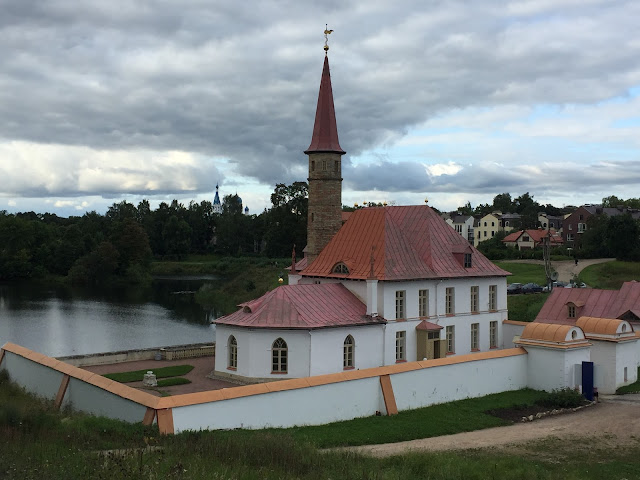120. St. Petersburg's suburban palaces #4 - Priory Palace
The Priory Palace is technically on the grounds of the Gatchina Palace, but it is impressive - and unusual - enough to merit its own blog post. It's perhaps a 20-minute walk east of Gatchina Palace, and is on the far shore of Black Lake. It's on the opposite side of the main road that goes through the town, so most visitors to Gatchina Palace and the surrounding park do not visit Priory Palace.
The Priory Palace is the only surviving example in Russia from the late 18th century of a rammed earth building. The building includes various construction materials, but the majority of the walls are made from compacted dirt and connected with lime mortar. This was a trendy construction technique for a time in Russia - due to its lower cost, ease of construction, and improved durability, but fell out of favor eventually and no other similar buildings from that era in Russia have survived intact to the 21st century.
The Priory Palace is a key part of the fascinating and little-known story of how the Russian Emperor Paul I became the Grand Master of the Knights of Malta. He had always been interested in this Roman Catholic chivalric order that had been founded in Jerusalem around 1099 CE (and based seven centuries later in the Mediterranean island of Malta), also known in various incarnations as the Knights Hospitaller, Order of Saint John, the Sovereign Military Order of Malta. Because the Knights of Malta were a sovereign power under international law, and influential in the 18th century, Catherine the Great and Paul I had frequent contact with them from the 1760s-1790s. When Napoleon Bonaparte invaded Malta in 1798, Paul took it as a personal insult and this was one of the precipitating factors that led Russia to declare war against France in the War of the Second Coalition.
After Napoleon took the Maltese capital city of Valletta, many of the Knights of Malta sought refuge in St. Petersburg, and they elected Paul as the Grand Master, even though he was a member of the Russian Orthodox rather than Roman Catholic faith (because of this, Catholic canon law did not approve the choice and he was the de facto rather than de jure head of the order). Roughly 10 years later, the Russian branch of the order seems to have been abolished, and the Knights of Malta in other parts of Europe rose to prominence, eventually establishing themselves in Rome. While they were in St. Petersburg, though, they used the Priory Palace as one of their primary gathering places as well as storage for some of their treasures and religious relics.
The Priory Palace is now set up as a museum. The first floor is dedicated to the history of the Knights of Malta in Russia, and the second floor exhibits focus on the design techniques and architectural context of the Palace itself. Although much smaller than Gatchina Palace, I spent almost as much time here due to the excellent information provided in the English-language audio guide and my interest in the unusual and unexpected history of the Knights of Malta in Russia.
The Priory Palace is the only surviving example in Russia from the late 18th century of a rammed earth building. The building includes various construction materials, but the majority of the walls are made from compacted dirt and connected with lime mortar. This was a trendy construction technique for a time in Russia - due to its lower cost, ease of construction, and improved durability, but fell out of favor eventually and no other similar buildings from that era in Russia have survived intact to the 21st century.
The Priory Palace is a key part of the fascinating and little-known story of how the Russian Emperor Paul I became the Grand Master of the Knights of Malta. He had always been interested in this Roman Catholic chivalric order that had been founded in Jerusalem around 1099 CE (and based seven centuries later in the Mediterranean island of Malta), also known in various incarnations as the Knights Hospitaller, Order of Saint John, the Sovereign Military Order of Malta. Because the Knights of Malta were a sovereign power under international law, and influential in the 18th century, Catherine the Great and Paul I had frequent contact with them from the 1760s-1790s. When Napoleon Bonaparte invaded Malta in 1798, Paul took it as a personal insult and this was one of the precipitating factors that led Russia to declare war against France in the War of the Second Coalition.
After Napoleon took the Maltese capital city of Valletta, many of the Knights of Malta sought refuge in St. Petersburg, and they elected Paul as the Grand Master, even though he was a member of the Russian Orthodox rather than Roman Catholic faith (because of this, Catholic canon law did not approve the choice and he was the de facto rather than de jure head of the order). Roughly 10 years later, the Russian branch of the order seems to have been abolished, and the Knights of Malta in other parts of Europe rose to prominence, eventually establishing themselves in Rome. While they were in St. Petersburg, though, they used the Priory Palace as one of their primary gathering places as well as storage for some of their treasures and religious relics.
The Priory Palace is now set up as a museum. The first floor is dedicated to the history of the Knights of Malta in Russia, and the second floor exhibits focus on the design techniques and architectural context of the Palace itself. Although much smaller than Gatchina Palace, I spent almost as much time here due to the excellent information provided in the English-language audio guide and my interest in the unusual and unexpected history of the Knights of Malta in Russia.























Comments
Post a Comment